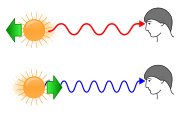Doppler Effect
Doppler Effect
|
The apparent change in frequency and wavelength due to the motion of the source and/or the observer. 3 types of Doppler Effect: |
An Example Of The Doppler Effect Found In Wild Life:
Bats are nocturnal predators and they use the Doppler effect to estimate the distance between themselves and their prey.
Red Shift
|
Red shift is defined as an increase in the wavelength of electromagnetic radiation waves moving away from observer - low frequency waves - longer wavelength |
I think the Doppler Effect Applet external link was an alright attempt at helping me understand the Doppler effect but there needs to be more of an explaination to make it clear.
The police car demo gave a clear visual of how the doppler effect works but i think a few sentences needs to be added to give more of an explanation of the demo.
Blue Shift
|
-Blue shift is defined as a decrease in wavelength waves moving towards observer - high frequency waves - shorter wavelength |
FYI
The Doppler Effect does not occur at 90 degrees (right angle).
A Helicopter's spinning turbine frequency is heard when perpindicular to you.
External Resources
Police Car this link gives a good visual understaning of the doppler effect and is easy to use and is fun to play around with. however no notes are given. i give this site 2/5 stars. Spar300
This site is on topic and helpful. Definatly should be kept. jshe128
Doppler Effect DemoThis is a short and sweet explanation of the doppler effect. It simply explains the relationship between the speed of the source and the observed sound in terms of wave frequency.On topic, very clear, there are other similar resources but a little variety is fine. Keep it. It's helpfulness depends on wether you understand the doppler effect or not. Repeats what we've learned in class- perhaps best as a revision tool.Bada003 12:23, 30 May 2008 (NZST)
Basic video explanation of Doppler shift(http://nz.youtube.com/watch?v=iN3fO5l4Rww&feature=related)
Video on youtube about the doppler effect: http://www.youtube.com/watch?v=C2J0LpS7hKo&feature=related
http://www.astro.ubc.ca/~scharein/a311/Sim/doppler/Doppler.html

